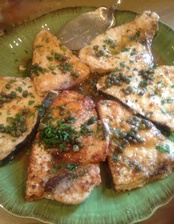Wine With…Swordfish Piccata
After a prolonged cool spring here on the East Coast, summer has stormed in, quite literally, with thunder, driving rain showers, soaring temperatures, and high heat index readings. Perfect weather for swordfish piccata and glasses of cool, refreshing white wine!
swordfish piccata and glasses of cool, refreshing white wine!
One thing that makes this such a soothing summer dish is the tang of lemon and bright bite of capers. And thin swordfish steaks rather than thicker, meatier ones give an overall impression of light, delicate fare — a distinct bonus in hot weather. Since preparation time is minimal, no one has to spend much time in a hot kitchen. Serve the piccata with simple rice or pasta drizzled with olive oil and a scattering of Parmesan.
Swordfish Piccata
(serves four)
Swordfish steaks, about two pounds total
½ cup flour
Salt and pepper
Cayenne
1 tablespoon olive oil
2 tablespoon butter (plus more for greasing oven pan)
½ cup white wine
¼ cup fresh lemon juice
3 tablespoons capers
2 tablespoons finely minced parsley
Preheat the oven to 350°.
If the swordfish steaks are more than 1-1 ½ inches thick, slice them in half horizontally to divide each one into 2 pieces. Spread the flour on a large, flat plate and season it with salt, pepper, and a little cayenne. Dredge each fish steak lightly in the seasoned flour, shaking off the excess.
Lightly grease the bottom of a sided baking dish with butter and set aside. Place one tablespoon each of olive oil and butter in a large skillet set over medium-high heat. When the mixture is foaming and the pan is very hot, add the fish in a single layer. Sear each steak for a couple of minutes on each side, adjusting the heat so that the fish browns slightly without burning. Don’t overcrowd it; cook the fish in batches, adding more butter and oil to the skillet if necessary. When the swordfish is just cooked through, transfer each piece to the baking dish and place it in the oven to keep warm.
Once all the fish is cooked, pour the wine into the skillet and cook over high heat, stirring constantly, until it is reduced by about half. Add the lemon juice and capers, plus one tablespoon of butter (or olive oil) and cook another minute or so.
Transfer the swordfish to a serving platter, pouring the juices that remain in the baking dish into the lemon mixture. Spoon this piccata sauce over the swordfish, garnish with parsley, and serve at once.
Swordfish is an inherently meaty fish, and in other guises it calls for a fairly robust wine. When we’ve grilled it, or served it with a tomato sauce, or made kebabs with it, our wines of choice have been either substantial, usually oak-influenced whites or gentle but still tannic reds. Swordfish piccata, however, is an entirely different kettle of . . . well, you get the idea.
|
Selection
|
Approx. Price |
Comments |
|
Abadia de San Campio, Rías Baixas (Spain) Albariño 2012 (Imported by Aveniu Brands)
|
$20 |
A slightly fleshy texture gives this Albariño heft on the palate but is offset by a zesty surge of acidity. The end result is a wine that offers substance and refreshment all at once.
|
|
Jean Claude Dagueneau, Pouilly Fumé (France) 2011 (Imported by Vineyard Brands)
|
$24 |
A subtle, sophisticated wine made with Sauvignon Blanc, this Pouilly exhibits a chalky, earthy undercurrent that adds interest while supporting its citrus-tinged fruit flavors. The lemon in the sauce brought out the latter, while the capers accented the former.
|
|
Heredad de Peñalosa, Rueda (Spain) Verdejo 2011 (Imported by The Spanish Wine Importers)
|
$13 |
The lightest and freshest-tasting of all the wines we tried, marked by pure direct flavors reminiscent of citrus and green apple fruit, this was a consensus favorite among the four people who tried it with the swordfish piccata. When its low price tag was revealed, enthusiasm for it grew even stronger.
|
|
Pieropan, Soave (Italy) 2011 (Imported by Neil Empson Selections)
|
$19 |
Consistently complete and complex vintage after vintage, the 2011 Pieropan Soave meshed neatly with the swordfish, its bright fruit and nutty undertones giving the dish a satisfying jolt of energy.
. |
|
St. Clement, Carneros Napa Valley (California) 2010
|
$19 |
We tried three Chardonnays with this dish, each hailing from a different place, and this one proved the most successful. Rich and buttery, it manages to stay in balance due to an almost electric bolt of acidity that runs through it. That sense of balance is what allowed it to pair successfully with a dish that itself contains so much vim and vigor.
|
